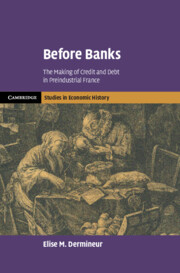Refine search
Actions for selected content:
240 results
5 - What Are the Perils of Voluntary Compliance?
-
- Book:
- Can the Public be Trusted?
- Published online:
- 11 October 2025
- Print publication:
- 30 October 2025, pp 121-142
-
- Chapter
-
- You have access
- Open access
- HTML
- Export citation
10 - A Neo-Kantian Approach to Competition Law?
-
-
- Book:
- Toward an Inframarginal Revolution
- Published online:
- 26 September 2025
- Print publication:
- 16 October 2025, pp 355-408
-
- Chapter
- Export citation
12 - The EU Regulatory Patchwork for Dark Patterns
-
-
- Book:
- Toward an Inframarginal Revolution
- Published online:
- 26 September 2025
- Print publication:
- 16 October 2025, pp 443-467
-
- Chapter
- Export citation
23 - So What?
- from Part Four - Tenured-Terminations
-
- Book:
- The War on Tenure
- Published online:
- 30 September 2025
- Print publication:
- 30 September 2025, pp 192-200
-
- Chapter
- Export citation
Fairness, justice, and criticality: Reviewing second language writing assessment
-
- Journal:
- Language Teaching , First View
- Published online by Cambridge University Press:
- 29 September 2025, pp. 1-28
-
- Article
-
- You have access
- Open access
- HTML
- Export citation
Passive inequality and the dilemma of meritocracy
-
- Journal:
- Experimental Economics / Volume 28 / Issue 2 / March 2025
- Published online by Cambridge University Press:
- 22 September 2025, pp. 379-400
-
- Article
-
- You have access
- Open access
- HTML
- Export citation
Weighing responsibilities: the allocation of fair refugee quotas
-
- Journal:
- International Theory , First View
- Published online by Cambridge University Press:
- 15 September 2025, pp. 1-21
-
- Article
-
- You have access
- Open access
- HTML
- Export citation
Fairness and willingness to compete
-
- Journal:
- Experimental Economics ,
- Published online by Cambridge University Press:
- 05 September 2025, pp. 1-19
-
- Article
-
- You have access
- Open access
- HTML
- Export citation
Ethical AI for language assessment: Principles, considerations, and emerging tensions
-
- Journal:
- Annual Review of Applied Linguistics / Volume 45 / March 2025
- Published online by Cambridge University Press:
- 01 September 2025, pp. 294-314
-
- Article
-
- You have access
- HTML
- Export citation
16 - Causation
- from Part IV - Liability and Evidence
-
-
- Book:
- The Cambridge Handbook on Climate Litigation
- Published online:
- 03 June 2025
- Print publication:
- 31 July 2025, pp 391-414
-
- Chapter
-
- You have access
- Open access
- HTML
- Export citation
14 - Intergenerational Equity
- from Part III - Regime Interaction and Interpretation
-
-
- Book:
- The Cambridge Handbook on Climate Litigation
- Published online:
- 03 June 2025
- Print publication:
- 31 July 2025, pp 344-368
-
- Chapter
-
- You have access
- Open access
- HTML
- Export citation
Sketches of fairness in EU and international law. Focus on the asylum and migration pact
-
- Journal:
- European Law Open ,
- Published online by Cambridge University Press:
- 14 July 2025, pp. 1-24
-
- Article
-
- You have access
- Open access
- HTML
- Export citation
Unraveling the SCARF: How dimensions of the SCARF model influence the relationship between workplace exclusion and turnover intentions
-
- Journal:
- Journal of Management & Organization , First View
- Published online by Cambridge University Press:
- 07 July 2025, pp. 1-28
-
- Article
-
- You have access
- Open access
- HTML
- Export citation

Before Banks
- The Making of Credit and Debt in Preindustrial France
-
- Published online:
- 27 June 2025
- Print publication:
- 23 January 2025
Exploring fairness in service robotics
- Part of
-
- Journal:
- Cambridge Forum on AI: Law and Governance / Volume 1 / 2025
- Published online by Cambridge University Press:
- 16 June 2025, e28
-
- Article
-
- You have access
- Open access
- HTML
- Export citation
Partisan preferences for antitrust policy
-
- Journal:
- Political Science Research and Methods , First View
- Published online by Cambridge University Press:
- 16 June 2025, pp. 1-11
-
- Article
-
- You have access
- Open access
- HTML
- Export citation
7 - How Do Children Learn Right from Wrong?
- from Section II - Middle Childhood
-
- Book:
- Child Development
- Published online:
- 19 June 2025
- Print publication:
- 12 June 2025, pp 105-121
-
- Chapter
- Export citation
11 - Growing Up Globally – Middle Childhood
- from Section II - Middle Childhood
-
- Book:
- Child Development
- Published online:
- 19 June 2025
- Print publication:
- 12 June 2025, pp 166-176
-
- Chapter
- Export citation
9 - Effectiveness, Fairness, and Responsiveness
- from Part III - Implementing Economic Governance
-
- Book:
- Balancing Pressures
- Published online:
- 02 May 2025
- Print publication:
- 22 May 2025, pp 212-233
-
- Chapter
- Export citation
Shaping an adaptive approach to address the ambiguity of fairness in AI: Theory, framework, and illustrations
- Part of
-
- Journal:
- Cambridge Forum on AI: Law and Governance / Volume 1 / 2025
- Published online by Cambridge University Press:
- 16 May 2025, e22
-
- Article
-
- You have access
- Open access
- HTML
- Export citation
